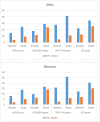Secondary prevention in diabetic and nondiabetic coronary heart disease patients: Insights from the German subset of the hospital arm of the EUROASPIRE IV and V surveys
- PMID: 36166067
- PMCID: PMC9898414
- DOI: 10.1007/s00392-022-02093-0
Secondary prevention in diabetic and nondiabetic coronary heart disease patients: Insights from the German subset of the hospital arm of the EUROASPIRE IV and V surveys
Abstract
Background: Patients with coronary heart disease (CHD) with and without diabetes mellitus have an increased risk of recurrent events requiring multifactorial secondary prevention of cardiovascular risk factors. We compared prevalences of cardiovascular risk factors and its determinants including lifestyle, pharmacotherapy and diabetes mellitus among patients with chronic CHD examined within the fourth and fifth EUROASPIRE surveys (EA-IV, 2012-13; and EA-V, 2016-17) in Germany.
Methods: The EA initiative iteratively conducts European-wide multicenter surveys investigating the quality of secondary prevention in chronic CHD patients aged 18 to 79 years. The data collection in Germany was performed during a comprehensive baseline visit at study centers in Würzburg (EA-IV, EA-V), Halle (EA-V), and Tübingen (EA-V).
Results: 384 EA-V participants (median age 69.0 years, 81.3% male) and 536 EA-IV participants (median age 68.7 years, 82.3% male) were examined. Comparing EA-IV and EA-V, no relevant differences in risk factor prevalence and lifestyle changes were observed with the exception of lower LDL cholesterol levels in EA-V. Prevalence of unrecognized diabetes was significantly lower in EA-V as compared to EA-IV (11.8% vs. 19.6%) while the proportion of prediabetes was similarly high in the remaining population (62.1% vs. 61.0%).
Conclusion: Between 2012 and 2017, a modest decrease in LDL cholesterol levels was observed, while no differences in blood pressure control and body weight were apparent in chronic CHD patients in Germany. Although the prevalence of unrecognized diabetes decreased in the later study period, the proportion of normoglycemic patients was low. As pharmacotherapy appeared fairly well implemented, stronger efforts towards lifestyle interventions, mental health programs and cardiac rehabilitation might help to improve risk factor profiles in chronic CHD patients.
Keywords: Coronary heart disease; Diabetes Mellitus; EUROASPIRE; Secondary Prevention.
© 2022. The Author(s).
Conflict of interest statement
K.U., J.K., B.K., J.Kr. are fellows of the Graduate School of Life Sciences, University Würzburg. J.K., B.K., J.Kr. received a doctoral thesis stipend from the Graduate School of Life Sciences at University Würzburg. S.W. reports grants from the German Ministry of Research and Education and Deutsche Herzstiftung e.V. G.E. reports personal fees from Astra-Zeneca, Abbott, Boehringer Ingelheim, Novartis, and Vifor, all outside the submitted work. He further acknowledges nonfinancial support from the University Hospital Würzburg, nonfinancial support from Comprehensive Heart Failure Center Würzburg, and grant support from German Ministry for Education and Research (BMBF). St.St. reports grants from the German Ministry of Research and Education, grants and other from Boehringer, Bayer, Thermo Fisher, and Pfizer; other from Astra-Zeneca, Sanofi, Servier, Alnylam, Ionis, and Akcea; grants, personal fees, non‐financial support, and other from Novartis, outside the submitted work. P.U.H. reports grants from the German Ministry of Education and Research, German Research Foundation, European Union, Berlin Chamber of Physicians, German Parkinson Society, University Hospital Würzburg, Robert Koch Institute, German Heart Foundation, Federal Joint Committee (G‐BA) within the Innovationfond, University Hospital Heidelberg (within RASUNOA-prime; supported by an unrestricted research grant to the University Hospital Heidelberg from Bayer, BMS, Boehringer Ingelheim, and Daiichi Sankyo), Charité–Universitätsmedizin Berlin (within Mondafis; supported by an unrestricted research grant to the Charité from Bayer), and University Göttingen (within FIND-AF randomized; supported by an unrestricted research grant to the University Göttingen from Boehringer Ingelheim) outside the submitted work. M.W., R.L., S.F., T.G., W.K., R.P., C.H., M.N., T.L., D.W., K.K. have nothing to report.
Figures



References
-
- Deutsche Herzstiftung e V 2021 32 Deutscher Herzbericht https://www.herzstiftung.de/system/files/2021-06/Deutscher-Herzbericht-2...
-
- Piepoli MF, Hoes AW, Agewall S, Albus C, Brotons C, Catapano AL, Cooney MT, Corra U, Cosyns B, Deaton C, Graham I, Hall MS, Hobbs FDR, Lochen ML, Lollgen H, Marques-Vidal P, Perk J, Prescott E, Redon J, Richter DJ, Sattar N, Smulders Y, Tiberi M, van der Worp HB, van Dis I, Verschuren WMM, Binno S, Group ESCSD 2016 European Guidelines on cardiovascular disease prevention in clinical practice: the sixth joint task force of the european society of cardiology and other societies on cardiovascular disease prevention in clinical practice (constituted by representatives of 10 societies and by invited experts)developed with the special contribution of the European Association for Cardiovascular Prevention & Rehabilitation (EACPR) Eur Heart J. 2016;37(29):2315–2381. doi: 10.1093/eurheartj/ehw106. - DOI - PMC - PubMed
Publication types
MeSH terms
Substances
Grants and funding
LinkOut - more resources
Full Text Sources
Medical
Research Materials

